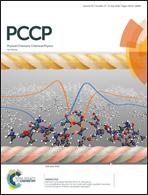Dissociative electron attachment induced ring opening in five-membered heterocyclic compounds
Abstract
Five-membered heterocyclic structures, which exist widely in biological systems and play an active role in various biochemical processes, have been studied extensively from a fundamental perspective. Here, the fragmentation patterns of isoxazole, a representative five-membered heterocycle, upon dissociative electron attachment (DEA) were examined carefully by comparing isoxazole's products with those of its methylated derivatives. It was found that the most dominant DEA pathway occurs through the loss of hydrogen at C(3), which leads to ring opening by O–N bond cleavage at an energy of ∼1.5 eV. The ring opening was investigated further for DEA to other related five-membered ring compounds, i.e., oxazole and thiazole. The DEA-induced hydrogen loss was much less pronounced or quenched completely in these two compounds and simultaneous ring-opening behavior was not detected. This observation is of special interest to applied fields, for example, the pharmaceutical industry, because several drugs that contain isoxazole substructures exhibit extensive ring opening during biotransformation.

- This article is part of the themed collection: 2018 PCCP HOT Articles


 Please wait while we load your content...
Please wait while we load your content...